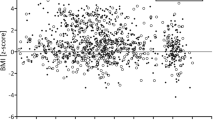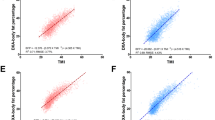Abstract
Objective: To explore the relationships between height and (a) fat-free mass (FFM) and (b) fat mass (FM) in children in order to determine the optimum means of adjusting body composition for height.
Design: Cross-sectional study.
Subjects: Sixty-nine children aged 8 y.
Measurements and Methods: Weight and height (HT) were measured, and total body water by deuterium dilution for estimation of fat-free mass and fat mass. The indices FFM/HT2 and FM/HT2 were calculated, as were the indices FFM/HTp and FM/HTp where P was selected in order to eliminate the correlation of these indices with height.
Results: FFM was optimally adjusted for height by calculating FFM/HT2. FM was optimally adjusted by calculating FM/HT6. However, height accounted for <8% of the variation in FM/HT2, indicating that the bias of this simpler index is small.
Conclusions: Different adjustments of FFM and FM for height are possible, depending on the study design. The indices FFM/HT2 and FM/HT2 are appropriate for many purposes, and have the advantage of expressing both aspects of body composition in common units. However, in some scenarios a more sophisticated approach is required for evaluating body fatness.
This is a preview of subscription content, access via your institution
Access options
Subscribe to this journal
Receive 12 print issues and online access
$259.00 per year
only $21.58 per issue
Buy this article
- Purchase on Springer Link
- Instant access to full article PDF
Prices may be subject to local taxes which are calculated during checkout




Similar content being viewed by others
References
Wells JCK . A critique of the expression of paediatric body composition data Arch Dis Child 2001 85: 67–72.
Wells JCK . A Hattori chart analysis of body mass index in infants and children Int J Obes Relat Metab Disord 2000 24: 325–329.
Griffiths M, Payne PR, Stunkard AJ, Rivers JPW, Cox M . Metabolic rate and physical development in children at risk of obesity Lancet 1990 336: 76–78.
Van Itallie TB, Yang M, Heymsfield SB, Funk RC, Boileau RA . Height-normalized indices of the body's fat-free and fat mass: potentially useful indicators of nutritional status Am J Clin Nutr 1990 52: 953–959.
Cole TJ . Weight/heightp compared to weight/height2 for assessing adiposity in childhood: influence of age and bone age on P during puberty Ann Hum Biol 1986 13: 433–451.
Gasser T, Ziegler P, Seifert B, Prader A, Molinari L, Largo R . Measures of body mass and of obesity from infancy to adulthood and their appropriate transformation Ann Hum Biol 1994 21: 111–125.
Wells JCK, Fewtrell MS, Jones SC, Cole TJ . Comparison of body composition by DXA and deuterium in children aged 5 to 11 years Pediatr Res 1996 40: A429.
Wells JCK, Fuller NJ, Dewit O, Fewtrell MS, Elia M, Cole TJ . Four-component model of body composition in children: density and hydration of fat free mass and comparison with simpler models Am J Clin Nutr 1999 69: 904–912.
Freeman JV, Cole TJ, Chinn S, Jones PR, White EM, Preece MA . Cross sectional stature and weight reference curves for the UK, 1990 Arch Dis Child 1995 73: 17–24.
Cole TJ, Freeman JV, Preece MA . Body mass index reference curves for the UK, 1990 Arch Dis Child 1995 73: 25–29.
Davies PSW, Wells JCK . Calculation of total body water in infancy Eur J Clin Nutr 1994 48: 490–495.
Fomon SJ, Haschke F, Ziegler EE, Nelson SE . Body composition of reference children from birth to age 10 years Am J Clin Nutr 1982 35: 1169–1175.
Tse WY, Hindmarsh PC, Brook CGD . The infancy-childhood-puberty model of growth: clinical aspects Acta Paediatr Scand 1989 356 (Suppl): 38–43.
Barker M, Robinson S, Osmond C, Barker DJ . Birth weight and body fat distribution in adolescent girls Arch Dis Child 1997 77: 381–383.
Hediger ML, Overpeck MD, Kuczmarski RJ, McGlynn A, Maurer KR, Davis WW . Muscularity and fatness of infants and young children born small- or large-for-gestational-age Pediatrics 1998 102: E60.
Figueroa-Colon R, von Almen TK, Franklin FA, Schuftan C, Suskind RM . Comparison of two hypocaloric diets in obese children Am J Dis Child 1993 147: 160–166.
Epstein LH, Valoski A, Koeske R, Wing RR . Family-based behavioral weight control in obese young children J Am Diet Assoc 1986 86: 481–484.
Acknowledgements
We are extremely grateful to all the mothers who took part and to the midwives for their cooperation and help in recruitment. The whole ALSPAC study team comprises interviewers, computer technicians, laboratory technicians, clerical workers, research scientists, volunteers and managers who continue to make the study possible. ALSPAC could not have been undertaken without the financial support of the Medical Research Council, the Wellcome Trust, the Department of Health, and the Department of the Environment. The ALSPAC study is part of the WHO initiated European Longitudinal Study of Pregnancy and Childhood
Author information
Authors and Affiliations
Consortia
Rights and permissions
About this article
Cite this article
Wells, J., Cole, T. & ALSPAC study team. Adjustment of fat-free mass and fat mass for height in children aged 8 y. Int J Obes 26, 947–952 (2002). https://doi.org/10.1038/sj.ijo.0802027
Received:
Revised:
Accepted:
Published:
Issue Date:
DOI: https://doi.org/10.1038/sj.ijo.0802027
Keywords
This article is cited by
-
The association of intrauterine and postnatal growth patterns and nutritional status with toddler body composition
BMC Pediatrics (2023)
-
Fat-free/lean body mass in children with insulin resistance or metabolic syndrome: a systematic review and meta-analysis
BMC Pediatrics (2022)
-
Prenatal exposure to ambient air pollution and traffic and indicators of adiposity in early childhood: the Healthy Start study
International Journal of Obesity (2022)
-
Effects of inulin supplementation on body composition and metabolic outcomes in children with obesity
Scientific Reports (2022)
-
Myocardial tissue characterization by cardiovascular magnetic resonance T1 mapping and pericardial fat quantification in adolescents with morbid obesity. Cardiac dimorphism by gender
The International Journal of Cardiovascular Imaging (2022)



